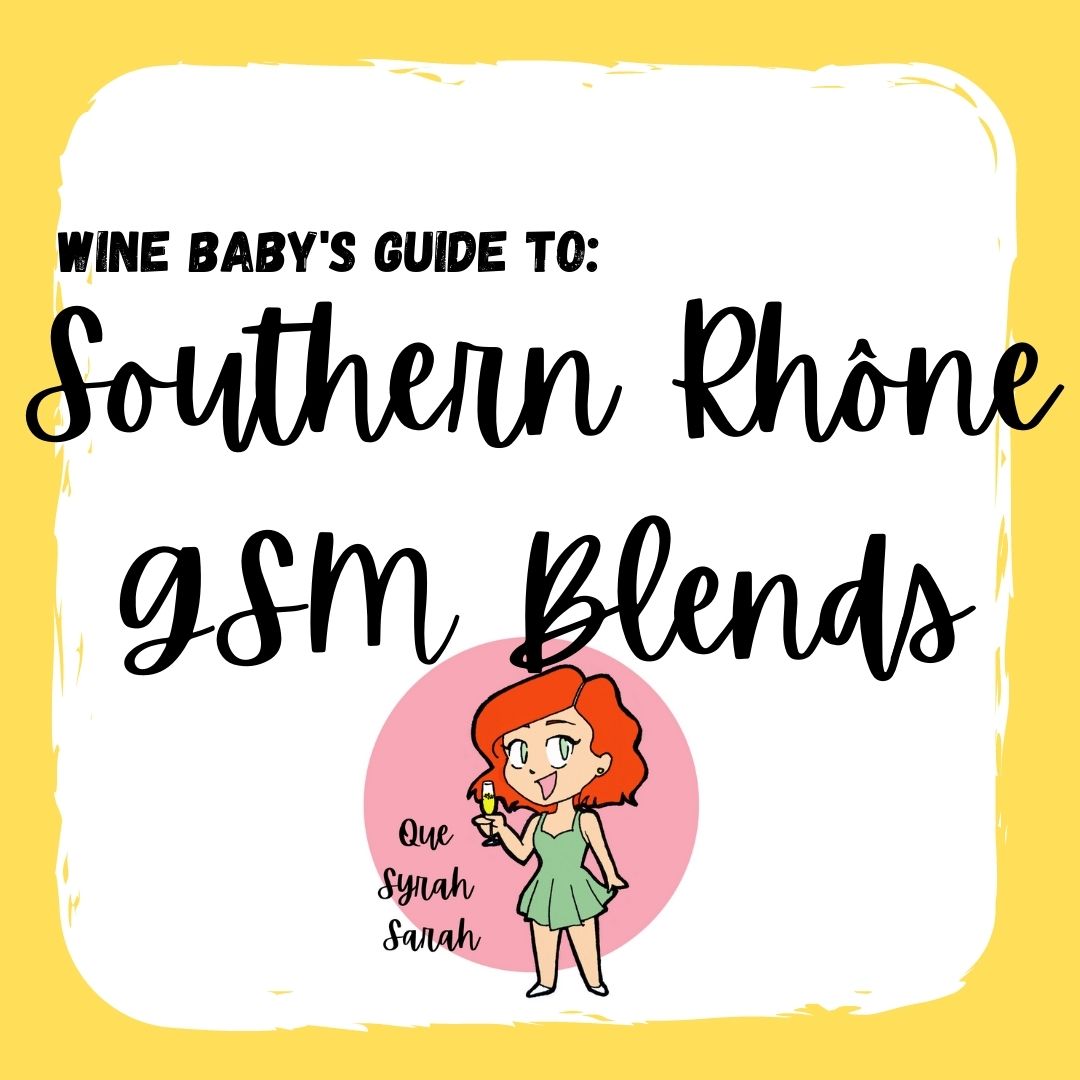
Wine Baby’s Guide to: GSM Blends
When I first head the phrase “GSM blend”, I was completely lost. What the heck is that? I thought to myself, but didn’t want to ask out loud because it seemed like everyone else with in the loop except for me.
So if that’s you, let me help you out, and introduce you to this incredibly popular red blend.
“GSM” stands for Grenache-Syrah-Mourvèdre, and the birthplace of this particular blend is the Southern Rhône in France.
Although those three grape varietals provide the primary backbone for the blend, there is actually a LOT of flexibility available to winemakers because there are actually over a dozen other grape varietals that they are permitted to use! It would take forever to get into each one individually, though, so for you wine babies, we will stick with the core components you need to know.
Now, before we dive in too far, I also want to give you a heads up on a mistake I made when I first started out, so you won’t have to make it too. I didn’t realize there was such a vast difference between the Southern Rhône and Northern Rhône.
GSM blends are often labelled as “Côtes-du-Rhone”, and I definitely got that mixed up with “Côtes-Rôtie” (a region in the North) once while wine shopping. Although both great, they are not the same. Now you know.
TASTING GSM BLENDS
Grenache is the primary grape in this blend, but in order to reach it’s full potential, it is blended with Syrah and Mourvèdre to really give these wines the impact and reputation they have developed over the years. We will be taking a look at how each of these three key grapes contributes to the final blend to see how they come together to make something amazing.
Colour
Grenache on it’s own is somewhat lacking in colour, but Syrah and Mourvèdre more than make up for it to give us a deep rich red.
Nose
The aromas of a GSM blend are complex and varied because of the use of such different grape varietals as it’s building blocks.
Grenache starts us off with elegant red fruit characteristics, like raspberry and cherry jams. Syrah pumps things up with pepper and spice. And Mourvèdre gives us rich gamey and leathery notes.
Combined they create a rich symphony of black and red fruit, rosemary, olives, herbs and baking spices, and tobacco, leather and vanilla.
Interestingly, for such a big complex wine, it actually doesn’t have a lot of new oak aromas, as winemakers tend to choose to use cement or large format older barrels to really let the grapes complexity and terroir show through.
Palate
The great thing about blends is that different levels of each grape varietal can be tinkered with until maximum balance is reached resulting in some incredibly high quality wines.
While Grenache on it’s own is lighter, sweeter, fruity and low in tannins, Mourvèdre jumps in to add structure and acidity, and Syrah gives it some oomph.
You will end up with a wine that is medium-high in all categories: body, tannins, acid, and alcohol.
Pairing
GSM blends are incredibly versatile for pairing options because of how many layers of flavour you have to work with.
In particular, I’d recommend heading in a Mediterranean direction, as that’s the climate of the Southern Rhône. Think sage, rosemary, garlic and olives.
Personally, while writing this, all I can think about is a thick hunk of bread dipped in savoury flavoured olive oil, followed by lamb dressed in rosemary. Doesn’t that sound good??
SHOPPING FOR GSM BLENDS
The obvious place to start here is with France and the Southern Rhône, since it’s where this whole thing began.
As mentioned earlier, when selecting a bottle from the Southern Rhône, many of them are going to be labelled as “Côtes-du-Rhone”. If you can find one that specifies the “Village” (Côtes-du-Rhone Villages), then that’s a step up.
Want to go up another rung? Look for the famous Châteauneuf-du-Pape. Surprisingly, it’s fairly easy to find at least a bottle or two even in regular liquor stores and has fairly reasonable prices (unlike some Bordeaux counterparts).
As always with French wine, Crus are the highest level to keep an eye out for.
Want to look outside the French borders? No problem! The GSM blend has been widely imitated the world over.
Paso Robles, California, has gone to the trouble of really designing itself as the second-coming of the Southern Rhône, planting the same grape varietals and making the same blends.
South Africa has also had great success.
And, although not typically referred to as GSMs, many the same grape varietals are used as the base for Northern Spanish blends as well!
Want to learn more about Syrah? Check out my Wine Baby’s Guide to Syrah/Shiraz, here.






-
-
3 years
Tagged asti method, cava, champagne, lambrusco, methode traditionelle